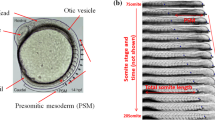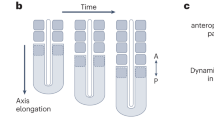Abstract
Somites are transient blocks of cells that form sequentially along the antero-posterior axis of vertebrate embryos. They give rise to the vertebrae, ribs and other associated features of the trunk. In this work we develop and analyse a mathematical formulation of a version of the Clock and Wavefront model for somite formation, where the clock controls when the boundaries of the somites form and the wavefront determines where they form. Our analysis indicates that this interaction between a segmentation clock and a wavefront can explain the periodic pattern of somites observed in normal embryos. We can also show that a simplification of the model provides a mechanism for predicting the anomalies resulting from perturbation of the wavefront.
Similar content being viewed by others
References
Baker, R.E., Schnell, S., Maini, P.K.: Formation of vertebral precursors: past models and future predictions. J. Theor. Med. 5 (1), 23–35 (2003)
Baker, R.E., Schnell, S., Maini, P.K.: A clock and wavefront mechanism for somite formation. Submitted to Dev. Biol, 2005
Collier, J.R., McInerney, D., Schnell, S., Maini, P.K., Gavaghan, D.J., Houston, P., Stern, C.D.: A cell cycle model for somitogenesis: mathematical formulation and numerical solution. J. Theor. Biol. 207, 305–316 (2000)
Cooke J., Zeeman, E.C.: A clock and wavefront model for control of the number of repeated structures during animal morphogenesis. J. Theor. Biol. 58, 455–476 (1976)
Dubrulle, J., McGrew, M.J., Pourquié O.: FGF signalling controls somite boundary position and regulates segmentation clock control of spatiotemporal Hox gene activation. Cell 106, 219–232 (2001)
Dubrulle, J., Pourquié, O.: From head to tail: links between the segmentation clock and antero-posterior patterning of the embryo. Curr. Op. Gen. Dev. 5, 519–523 (2002)
Dubrulle, J., Pourquié, O.: fgf8 mRNA decay establishes a gradient that couples axial elongation to pattering in the vertebrate embryo. Nature 427, 419–422 (2004)
Gossler, A., Hrabě de Angelis, M.: Somitogenesis. Curr. Top. Dev. Biol. 38, 225–287 (1998)
McInerney, D., Schnell, S., Baker, R.E., Maini, P.K.: A mathematical formulation for the cell cycle model in somitogenesis: parameter constraints and numerical solutions. IMA J. Math. Appl. Med. Biol. 21, 85–113 (2004)
Palmeirim, I., Henrique, D., Ish-Horowicz, D., Pourquié, O.: Avian hairy gene expression identifies a molecular clock linked to vertebrate segmentation and somitogenesis. Cell 91, 639–648 (1997)
Pourquié, O.: The segmentation clock: converting embryonic time into spatial pattern. Science 301, 328–330 (2003)
Pourquié, O.: The chick embryo: a leading model for model in somitogenesis studies. Mech. Dev. 121, 1069–1079 (2004)
Pourquié, O.: Pers. Comm., 2004
Primmett, D.R.N., Norris, W.E., Carlson, G.J., Keynes, R.J., Stern, C.D.: Periodic anomalies induced by heat shock in the chick embryo are associated with the cell cycle. Development 105, 119–130 (1989)
Primmett, D.R.N., Stern, C.D., Keynes, R.J.: Heat shock causes repeated segmental anomalies in the chick embryo. Development 104, 331–339 (1988)
Saga, Y.: Genetic rescue of segmentation defect in MesP2-deficient mice by MesP1 gene replacement. Mech. Dev. 75, 53–66 (1998)
Saga, Y., Hata, N., Koseki, H., Taketo, M.M.: Mesp2: a novel mouse gene expressed in the presegmented mesoderm and essential for segmentation initiation. Genes Dev. 2, 835–845 (2001)
Schnell, S., Maini, P.K.: Clock and induction model for somitogenesis. Dev. Dyn. 217, 415–420 (2000)
Schnell, S., Maini, P.K., McInerney, D., Gavaghan, D.J., Houston, P.: Models for pattern formation in somitogenesis: a marriage of cellular and molecular biology. C.R. Biologies 325, 179–189 (2002)
Stern, C.D., Fraser, S.E., Keynes, R.J., Primmett, D.R.N.: A cell lineage analysis of segmentation in the chick embryo. Development 104S, 231–244 (1988)
Stickney, H.L., Barresi, M.S.J., Devoto, S.H.: Somite development in zebrafish. Dev. Dyn. 219, 287–303 (2000)
Stockdale, F.E., Nikovits, W.J., Christ, B.: Molecular and cellular biology of avian somite development. Dev. Dyn. 219, 304–321 (2000)
Tabin, C.J., Johnson, R.L.: Clocks and Hox. Nature 412, 780–781 (2001)
Author information
Authors and Affiliations
Corresponding author
Rights and permissions
About this article
Cite this article
Baker, R., Schnell, S. & Maini, P. A mathematical investigation of a Clock and Wavefront model for somitogenesis. J. Math. Biol. 52, 458–482 (2006). https://doi.org/10.1007/s00285-005-0362-2
Received:
Revised:
Published:
Issue Date:
DOI: https://doi.org/10.1007/s00285-005-0362-2




